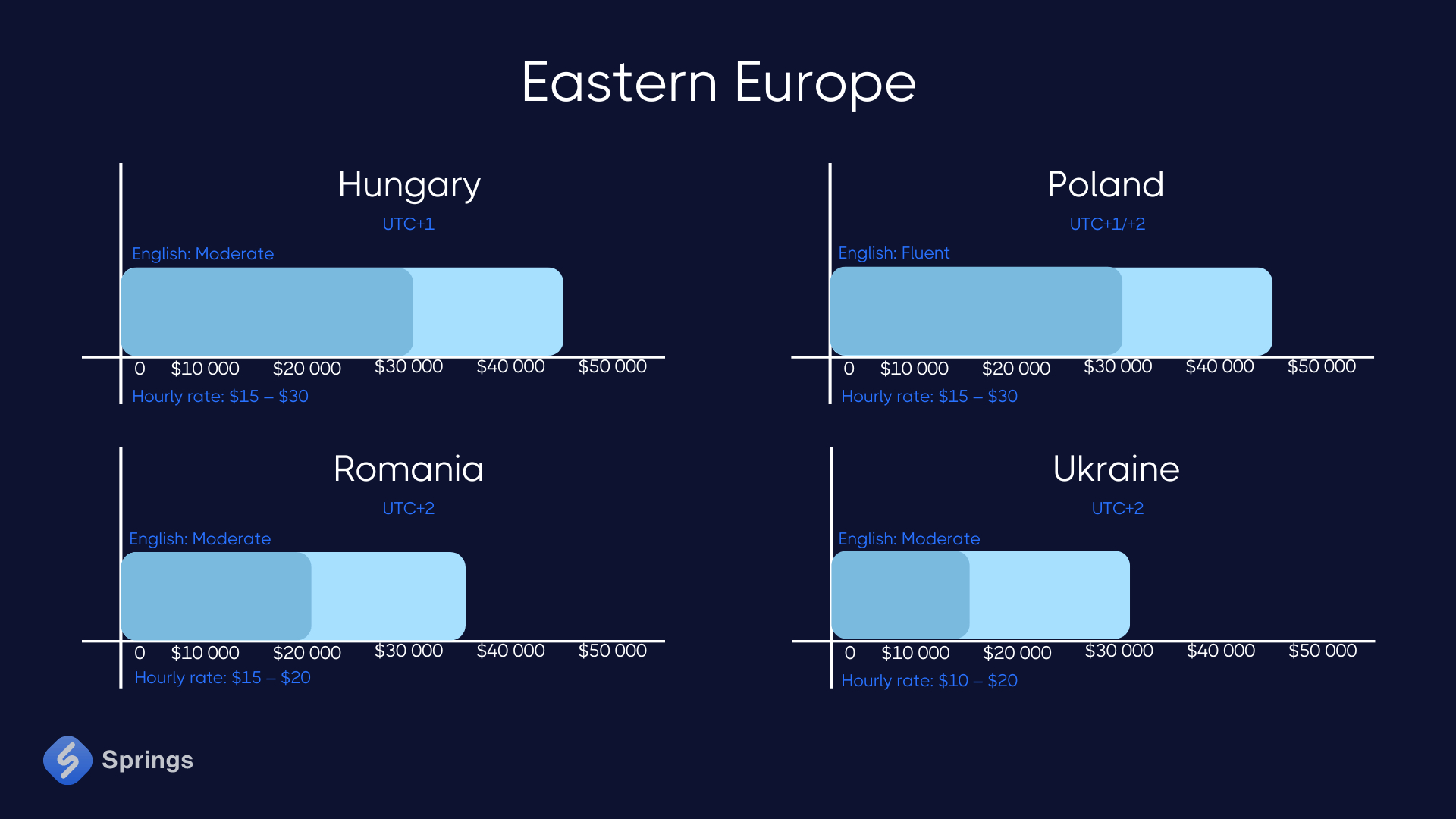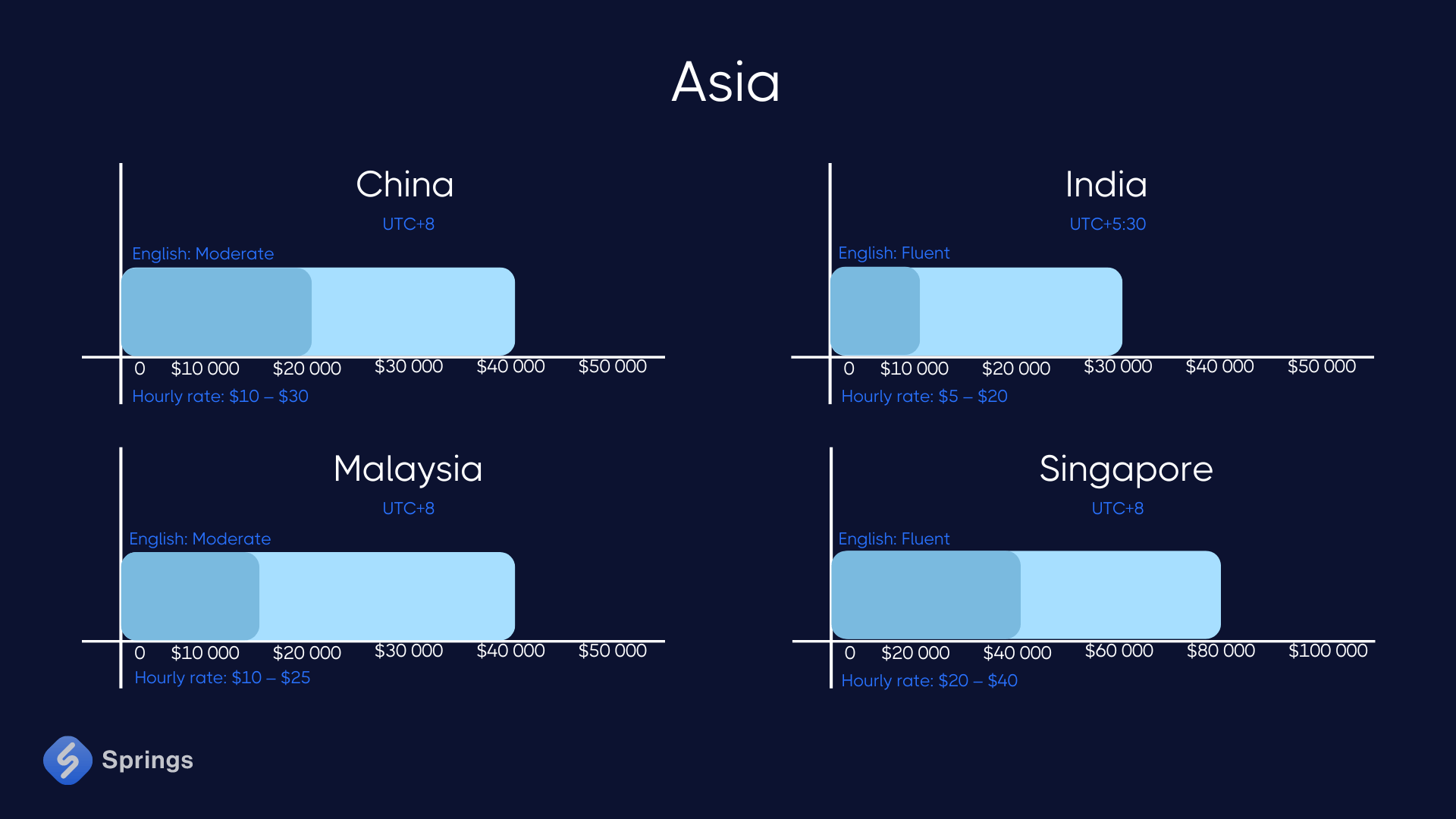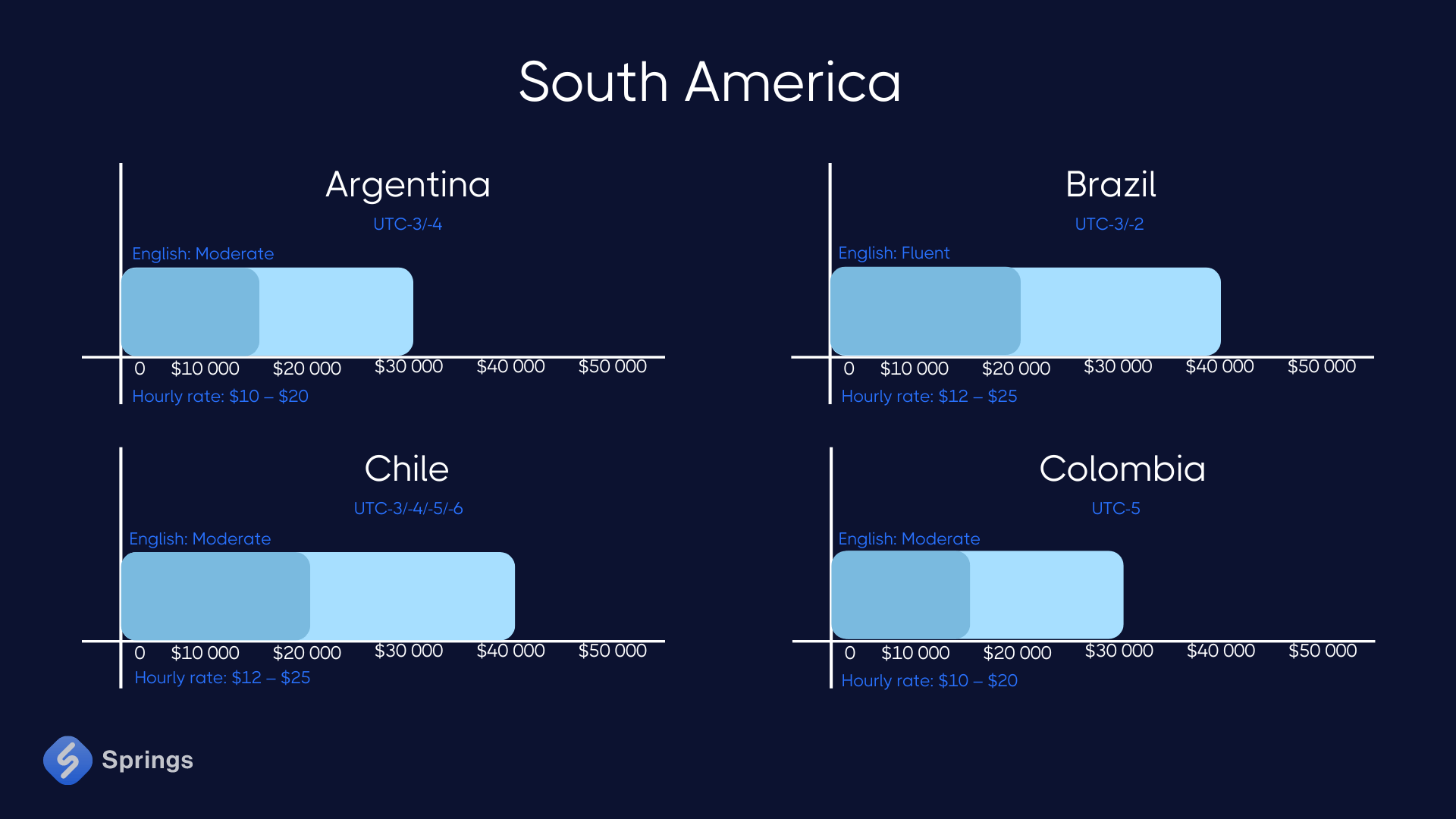Hiring Overseas Developers: Common Issues and How To Overcome Them
Modern software solutions allow enterprises to automate different processes, such as employee management, logistics, and customer relations. These products let them achieve more and spend less in the long run. According to Straits Research, the global market for business software and services is expected to reach $1,357 billion by 2031.

However, not all businesses find readily available solutions sufficient. As there’s often not enough local talent to choose from, remote teams become the only viable option for software creation. While finding the right one may seem like an easy task, many factors can prevent companies from working with overseas developers and getting the necessary results.
This guide explains the main issues companies encounter, where to search for developers, the costs of hiring them, and other aspects. Enterprises can use the presented information to narrow down their choices and select the most suitable candidates.
Why Hire Overseas Developers?
Several distinct factors make international teams a good alternative to hiring and managing internal employees.
- A large talent pool. Looking for professional overseas software development teams opens more opportunities for companies. Eastern Europe and Asia, in particular, can replace the drained talent pools of North America and Europe. This also increases the chances of enterprises finding the right people.
- Better flexibility and scalability. Working with remote experts allows businesses to get what they want without a long-term commitment. This option is more flexible, as teams can be scaled up and down based on project needs.
- Cost-effectiveness. Hiring local talent costs more than working with overseas experts, which can be problematic if an enterprise has a limited budget. However, the lower prices of overseas software development save enterprises significant expenses.
- Faster recruitment. Working with remote teams reduces time and effort in gathering, screening, and reviewing employee applications. Using this approach also saves enterprises from the trouble of onboarding and training programmers.
- Proven expertise. Offshoring software projects reduces the risks of choosing the wrong talent. There’s a high chance that candidates will have experience working on similar tools and services and avoid common mistakes associated with development.
Top Issues Associated With Hiring Overseas Developers
There are over 10,000 overseas software development companies for enterprises to choose from. But finding the right firm of specialists isn't a walk in the park. Enterprises can run into several issues during this process, affecting the development process at different stages.
- Communication barriers. Linguistic or cultural troubles can jeopardize project planning, discussions, and execution. Clients won’t be able to communicate their concerns properly, which will lead to more trouble and, in extreme cases, shut down production completely.
- Economic and political stability. The company cannot predict how much the project will cost if the country’s economy and political stability shift by the hour. Volatile exchange rates influence development costs and payments.
- Legal issues. Labor laws and regulations differ from country to country, which complicates the hiring process and leads to legal problems. Thus, it is important to look for firms that follow international security regulations and compliance standards.
- Project management problems. Enterprises can run into trouble with project management and programmer accountability. Due to different time zones and schedules, experts can be unavailable or take longer to respond.
- Technology and infrastructure. While it’s rare, there are regions on the planet where the internet connection isn’t as good or as stable as in the US and Europe. Offshore developers may also lack access to the same hardware and software tools as the people at the enterprise.
- Time zone differences. Having overseas software development teams work in a completely different time zone messes with scheduling meetings and real-time cooperation. These factors potentially slow down project development and cause gaps in communication.
- Quality control. Businesses can come across offshore developers that have a different perspective on the quality of produced work. Additionally, there might be problems with verifying the team’s experience and credentials.
Hiring Overseas Developers: What’s The Process?
Yielding better results with software projects requires several steps. They are the same for all products, whether a company wishes to build internal solutions or profitable software.
Define project goals and objectives
Begin by outlining the specific needs of your project and identifying it’s requirements. Clearly define the scope of your project, including its objectives, features, functionalities, and deliverables. Consider both short-term goals and long-term vision.
Then calculate the number of experts it will need and the budget.
Find the right location
Next, you need to research and select a geographical location where you will hire local talents. Look at countries with large talent pools in related skills and technologies. Additionally, compare the costs of working with offshore developers in different regions.
Check whether the time zones will be compatible for effective collaboration and communication. Finally, it’s important to establish language proficiency by talking to representatives from different companies. These conversations will help better understand what to expect from the partnership.
Work on a remote recruitment process
When the foundations are in place, you can begin the process of hiring a development team and choose a hiring platform or partner (see below). Write a detailed description of the project, its time zone, and the skills and abilities required to complete it. This document should mention the type of contract and other relevant details. Listing this data allows individual experts to better comprehend what they’re getting themselves into.
Review legal aspects
No matter which option your company chooses, you should understand the legal side of things. This involves studying the laws and regulations that govern programming contracts in particular countries. You should clearly spell out intellectual property rights on the final product.
At this point, it’s vital to see if candidates among overseas software development teams comply with the latest data security and privacy guidelines. Additionally, the firms in question must work under confidentiality and non-disclosure agreements to protect any details or sensitive data from being leaked.
Decide on the hiring model
There are several options: hire developers directly as remote employees, work with freelancers, or outsource to companies. The choice depends on the project's complexity. For example, it's doubtful that more than one or two developers will be enough to complete a complex AI/ML project.
Where To Find Overseas Developers?
Now that a business has a rough idea for its software project, it's time to look for offshore developers. There are several great places where companies can find talent. Check out several options before narrowing down the candidate pool.
Freelance Websites
These platforms represent a viable option for outsourcing programmer talent. If a business wants to work with such experts, it can visit platforms like Guru, Toptal, and Upwork. Of course, coordinating tasks and managing projects will involve more challenges than working with offshore teams when building one from scratch.
Review Platforms
Such websites have verified user reviews about different overseas firms worldwide. They offer detailed information on the teams and their success with previous projects. Platforms like GoodFirm, Clutch, and Wadline are good places to start. They have rating systems, client testimonials, and data on service types and hourly rates.
LinkedIn Network
This job platform is a powerful tool that helps companies find teams and individual programmers alike. Businesses use this website to browse pages of custom software development firms. It also won’t hurt to check out tech-related groups. Many freelance experts use them to share their opinions and tips about different technologies.
Cost of Hiring Overseas Developers
Prices vary based on region and country. The top regions enterprises can explore are their hourly rates, English proficiency, and time zones.
Eastern Europe
Countries like Ukraine, Hungary, Poland, and Romania have a robust presence in the IT offshore industry. The region is full of cost-effective, talented, and highly adaptable companies. Firms in this part of the world deliver consistent, high-quality, and timely projects. Here’s a bird' s-eye view of the market for offshore products.

Asia
This continent has been a hotspot for outsourcing software development. At least 4,000,000 experts work in this region, with extensive expertise in different projects. Local developers take only a fraction of what their US-based counterparts demand. India, China, and Singapore are some of Asia’s top destinations.

South America
Startups in this region are trendy among US companies thanks to their geographical proximity and compatible time zones. Argentina, Brazil, Colombia, and Chile are home to the region’s largest outsourcing firms. In 2020, they had a whopping 500,000 software engineers between them. Developers in this region show an admirable level of English proficiency.

How To Hire An Overseas Development Team Successfully: X Best Tips
Finding the best developers to work on a software project can be delicate, especially if the firm has yet to gain experience with this process. Several tips help improve their preparations and yield better results.
- Don’t rush things. Jumping on the first option an enterprise finds is never a good idea. Rushed decisions often result in regret soon after project development begins. Businesses should approach outsourcing firm selection with restraint and thoughtfulness.
- Ask around. Check out what previous clients say about their experience with these developers. Ask for direct contacts and talk about aspects of the programming process your firm is concerned about. For example, was everything done on time, how fast the team could adjust, etc.
- Check out previously delivered projects. To better understand what hiring overseas developers can do for you, explore their previous projects. The offshore company may have already worked on similar tools or services. This process helps enterprises comprehend better what they wish to achieve with the software.
- Establish communication lines. Once project development begins, there should be a clear way for the client and the firm to communicate. Ask the company about communication hours, platforms, and frequency. This will make it easier to discuss different things and make timely adjustments.
- Cover the groundwork. Finally, the enterprise should approach an offshore developer only after it’s prepared all the project details. Trying to make something without proper feature descriptions, budget, or time constraints leads to endless programming.
Red Flags To Watch Out For When You Hire An Overseas Programmer:
- Lack of Communication: If the candidates or the agency are slow to respond or unclear in their communication, this could indicate future issues with timely and effective communication.
- Vague Portfolios: Incomplete or ambiguous portfolios with unclear project details can be a sign of inexperience or lack of transparency.
- Inconsistent Pricing: Extremely low rates compared to the market standard might indicate low quality, while significantly high rates might not be justified. Ensure you understand what is included in the pricing.
- No References or Reviews: A lack of verifiable references, testimonials, or reviews from previous clients can be a red flag.
- Unclear Processes: If the development process, project management methodologies, or timelines are not clearly outlined, it can lead to misunderstandings and project delays.
- High Turnover Rates: Frequent changes in team members can disrupt project continuity and affect the quality of work.
- Language Barriers: Significant language barriers that could hinder effective communication and collaboration should be noted.
- Nonexistent Online Presence: If the developer or agency has little to no online presence, such as a website or LinkedIn profile, it may be a cause for concern.
- Legal and Compliance Issues: If the developer or agency seems unfamiliar with or unconcerned about legal and compliance requirements, it can lead to serious issues down the line.
- Unclear Contract Terms: Vague or overly complex contract terms, especially regarding deliverables, deadlines, and payment, can lead to disputes and misunderstandings.
The Bottom Line
Embarking on a journey to find the right remote software engineers is not an easy task. We hope that the facts, advice, and information provided in this article will help enterprises on this path and lead to the best software they can get their hands on. If you have any further questions about this process, our advisors are ready to help.





